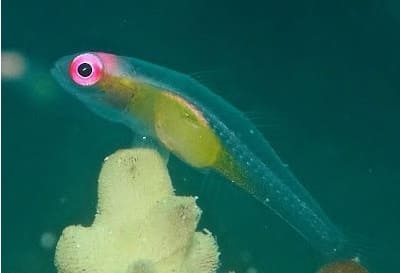Home › Ocean Life › Marine › Vertebrates › Gobies › Pandaka Pygmaea
Information about Dwarf Pygmy Goby
[Phylum: Chordata] [Class: Actinopterygii] [Order: Gobiiformes] [Family: Oxudercidae]
In their natural habitat, one of the smallest vertebrates in the world is a goby fish that rarely measures more than eleven (11) millimetres long - even when it reaches full maturity.
This section contains interesting facts and information about the dwarf pygmy goby fish, including where they live, what they eat, and how they reproduce.
Pandaka Pygmaea: Habitat and Distribution
Often referred to as the "Philippine goby", you will find this tiny tropical fish in the brackish water of shady river banks and mangroves.
Thus, pygmy gobies thrive best in the wetland areas and marine neritic and intertidal waters around Southeast Asia, especially:
- Bali and Sulawesi (Indonesia)
- Culion Island (Palawan, Philippines Islands)
- Malaysia and Singapore
- Thailand (the Andaman Sea)
Interesting Fact: The local extinction of dwarf pygmy goby (Pandaka pygmaea) from the Malabon region resulted in the milkfish (bangus) replacing it as the national fish of the Philippines.
Pygmy Goby Behaviour and Characteristics
Without a doubt, this species displays petiteness and brevity. Even so, it still retains the typical elongated 'slender' body that is prevalent with almost all gobies fishes.
In addition, its mostly colourless and transparent body are two of the most distinctive and recognisable features of this dwarfish hermaphrodite.
Here's the thing:
It is a narrow bodied fish with a broad, blunt head. For the most part, the species have dark spots of pigmentation scattered along the sides - and especially at the base of the fins.
The males tend to be smaller than the females. Hence, an adult male will generally grow up to nine (9) millimetres in length and a female could measure up to 1.5 centimetres long.
Despite having a somewhat 'arched' ventral outline, a mature adult will rarely weigh more than four (4) milligrams (0.00015 ounces).
Pro Tip: A brief look into the history of fish keeping shows imports of pygmy goby fishes starting in 1958 - for the German aquarium trade. As a result, it would not be uncommon to find larger specimens in home aquariums or at retail suppliers.
What Do Pygmy Gobies Eat?
Having a miniscule throat, and relatively poor vision for a fish, gobies tend to snack on small meals. So, the typical animal and plant-based food sources that dwarf gobies eat would usually consist of:
 Algae
Algae- Brine shrimp nauplii
- Crustaceans
- Mysis shrimps
- Planktonic organisms
- Plant and vegetable detritus
- Sea worms
- Zooplankton
Fun Fact: Large species of goby feed on other small fishes. Whereas, the smallest of the genera will stick to planktonic algae as a major food source.
Goby Fish Species Reproduction
Male and females typically share the burrow which provides them with a sheltered place to spawn. The genders dig with their mouths and keep the burrow clear of debris by fanning away sedimentary sand.
Goby females often lay up to 5,000 eggs during the reproductive period. The eggs stick to vegetation such as coral and substrate. The male supervises the eggs for a few days until they hatch as new colourless larvae.
Most of the young will only take a few months to reach adult maturity. In general, warm water dwellers can live for a period of up to ten (10) years.
Threat and Predators
Gobies have few predators because of their unique burrowing behaviour. Even so, some of the larger predatory fish species and wading birds will eat gobies if they can catch them.
Pro Tip: A recent assessment released by the IUCN Red List of Threatened Species in October 2020 lists the dwarf pygmy goby (Pandaka pygmaea) as being Data Deficient (DD).
Related Information and Help Guides
- Examples of Marine Vertebrates with Pictures
- Red Fire Goby Facts and Information with Pictures
- Violet Goby Dragon Fish Facts and Information
- Yellow-Prawn Goby Fun Facts and Information
- What is Fishkeeping: A Guide for Beginners
- Wrasse Fish Types Facts and Species Information
Note: The short video [4:13 seconds] presented by 'Eagle Aquatics' explains more about how to keep the firefish goby in captivity as a pet.